|
|
|
 |
 |
 > The Archipelago > Endemic Species > The Galapagos and Charles Darwin dilluns, 30 d'abril de 2007
Located in the middle of the Pacific Ocean, the Galapagos Archipelago is a treasure of both land and sea, with unique flora and fauna. This exceptional example of biodiversity, however, finds itself under threat, as we have been reminded by various organisations over recent weeks.
For instance, on 10 April, the Ecuadorian government (the Galapagos are a province of Ecuador) declared that the archipelago was at risk and that managing and protecting its ecosystem was a national priority. The measure received the support of conservation organisations such as the Charles Darwin Foundation, which has worked on the Galapagos for the last fifty years. Support was also expressed from the United Nations Educational, Scientific and Cultural Organisation (UNESCO), which, after a visit to the islands between 8 and 13 April, confirmed the danger that threatens the Galapagos Natural Park. According to UNESCO, the reasons behind the current problems are: the growing proliferation of non-native plants and animals, the increase in human immigration, the immeasurable growth of tourism, and the disastrous management by different institutions and agencies.
The ArchipelagoThe Galapagos Archipelago, volcanic in origin and situated 1,000 km off the Ecuadorian coast, is made up of about 20 islands and by more than two hundred islets and reefs. The Galapagos Islands cover 8,000 km², almost 97% of which form part of the natural park, and the surrounding waters make up an extremely extensive marine reserve. The Galapagos have been described as the end of the world, on account of their geographic isolation, something that has not stood in the way of the proliferation of tourism and the growth in the population, which has been very much in evidence over recent decades. Today, almost 30,000 people live on the archipelago.
Endemic SpeciesThe geographic isolation of the Galapagos Islands explains their abundance of endemic species (species that are only found in a specific geographical area). Of particular interest amongst the Islands' flora are the 'tree cacti'. And as for fauna, what stand our are the land iguanas, the so-called Darwin finches and the famous giant tortoises that can grow to more than 170 centimetres, weigh more than 300 kg and live to be 100! Out of the 2,900 reported marine species, 18% are endemic. Worth special mention is the marine iguana, the only reptile capable of going into the sea to look for food.
The Galapagos and Charles DarwinOn the list of illustrious visitors to the Galapagos is the English naturalist Charles Darwin (1809-1882), father of the theory of evolution. His stay on the islands, as part of his circumnavigation voyage on board the Beagle, gave him the opportunity to observe a great number of unique species. This had a great influence on the development of his evolutionist theory which was published in 1859 in his book 'The Origin of Species'. However, Darwin's theory was not one that occurred to him in a moment of inspiration on the Galapagos themselves, as legend has it but, rather, one that developed slowly.
|
Investiga

> Les amenaces que planen sobre les Galápagos, segons la UNESCO.

> Vídeo sobre les tortugues que habiten l'arxipèlag.

> La biodiversitat de les Galápagos, en imatges.
I també...
- Un qüestionari.
- El viatge de Charles Darwin a bord del Beagle.
- Projecte Beagle: el desafiament de repetir-lo amb un vaixell idèntic.
- Espècies invasores de les Galápagos.
Portada |
Europa Press |
El Punt |
La premsa |
Especials |
Diari de l'escola |
LesFinances.info |
Editorials |
Mail obert |
Els blocs |
Lletres
Tecnologia i ciència | Solidaritat | Cap de 7mana | Campus | El 9 | Presència | Fòrums | Enquestes | Xat | Correu
Traductor | Edicions en Pdf | Wap-pda | Biblioteca | Lletra més grossa
Tecnologia i ciència | Solidaritat | Cap de 7mana | Campus | El 9 | Presència | Fòrums | Enquestes | Xat | Correu
Traductor | Edicions en Pdf | Wap-pda | Biblioteca | Lletra més grossa
| Què és VilaWeb? Publicitat Mapa web Contacte | Una web de Partal, Maresma i Associats, S.L. |





